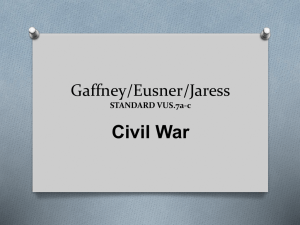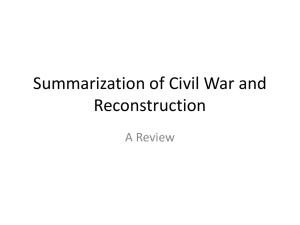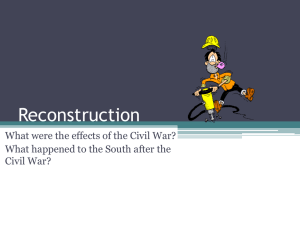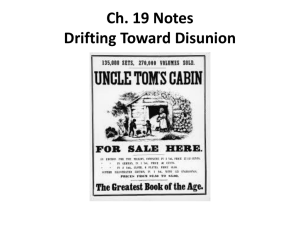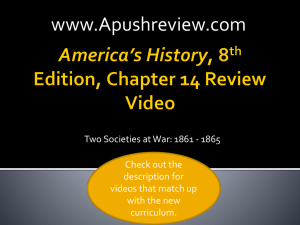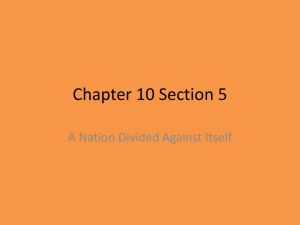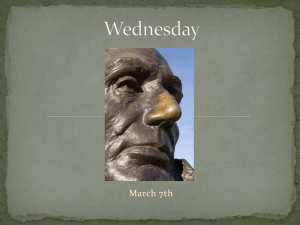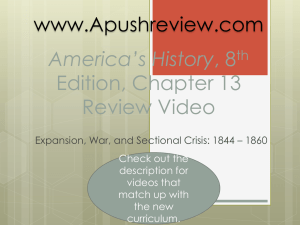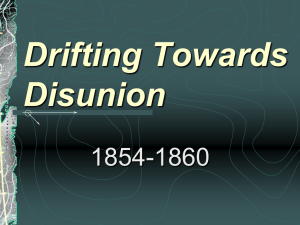File
advertisement
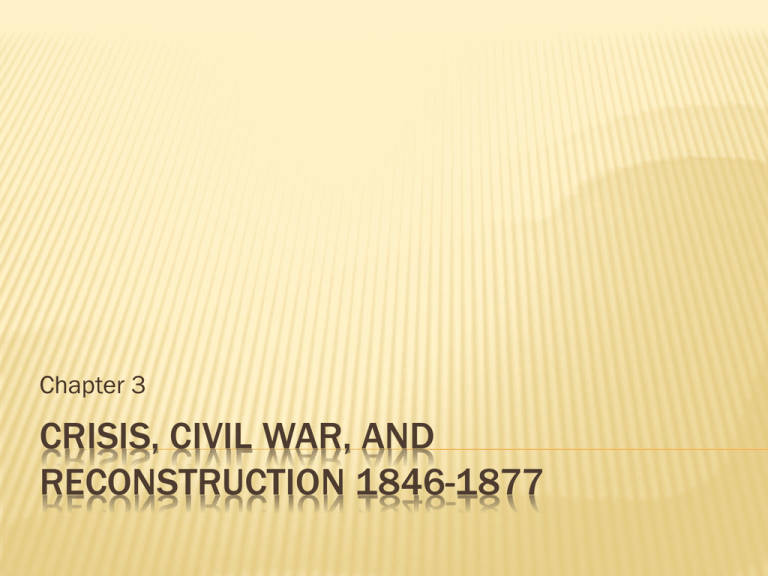
Chapter 3 CRISIS, CIVIL WAR, AND RECONSTRUCTION 1846-1877 SECTION 1: THE UNION IN CRISIS SECTION FOCUS QUESTION How did the issue of slavery divide the union? SLAVERY AND WESTERN EXPANSION The Mexican-American War highlighted the issue of slavery in the United States Wilmot Proviso – called for a ban on slavery in any territory that the United States gained for this war Southerners denounced the proposal but it passed the Republican dominated House of Representatives A NEW PARTY OPPOSES SLAVERY New political parties are ignited by the antislavery movement Free-Soil Party – northern opponents of slavery CONGRESS TRIES TO COMPROMISE 1850 California applied to enter the Union as a free state ( non-slave) Compromise of 1850 – this measure admitted California as a free state but allowed other territory acquired from Mexico voter would get to decide Popular Sovereignty – this is the idea of voters deciding for or against slavery in new states CONT… The 1850 Compromise also included the Fugitive Slave Act. Arrest suspected runaway slaves No jury trial Required citizens to help capture runaways THE ROAD TO DISUNION Harriet Beecher Stowe – author of Uncle Tom’s Cabin, showed the plight of slaves in the south “So you are the little woman who wrote the book that made this great war” President Lincoln THE KANSAS – NEBRASKA ACT Kansas-Nebraska Act – divided the Nebraska Territory into Kansas and Nebraska, allowing voters in each territory to decide the issue of slavery VIOLENCE ERUPTS IN KANSAS May 21st 1856 proslavery forces attacked the free-state town of Lawrence, Kansas John Brown – moved to Kansas hoping to confront the issue of slavery head-on Brown and his men murdered five pro-slave settlers near Pottawatomie Creek THE REPUBLICAN PARTY EMERGES Opposition to slavery led to the creation of the new Republican Party in 1854 The presidential election of 1856 James Buchanan – he would “stop the agitation of the slavery issue (Democrat) “Won the election” John C. Fremont – opposed the spread of slavery (Republican) THE DREAD SCOTT DECISION INFLAMES THE NATION Dred Scott v. Sandford – the court ruled against Scott. The court ruled that blacks were not citizens and, therefore, were not entitled to sue in the courts THE LINCOLN-DOUGLAS DEBATES Abraham Lincoln – Republican challenger to Senator Stephen Douglas a Democrat Lincoln called for political equality for African Americans but not immediate abolition Douglas saw the issue of slavery as being solved by popular sovereignty JOHN BROWN PLANS A REVOLT Brown saw the political process to slow in ending slavery and saw violence as the best answer. Harpers Ferry, Virginia SECTION 2: LINCOLN, SECESSION, AND WAR SECTION FOCUS QUESTION How did the Union finally collapse into a civil war? THE ELECTION OF 1860 John Brown, Kansas, Supreme Court (Dred Scott), and the Fugitive Slave Act’s intrusion into the states’ independence further fueled the flames of war Jefferson Davis – Mississippi senator, convinced Congress to restrict federal control over slavery DEMOCRATS SPLIT THEIR SUPPORT The Democrats held their nomination convention in Charleston, N.C.. They split their party over the issue of federal protection vs. popular sovereignty John C. Breckinridge – nominated Vice President by southern Democrats WHIGS MAKE A LAST EFFORT The Whigs joined the Know-Nothings to create the Constitutional Union Party with the platform to uphold “the Constitution of the country, the Union of the States and the enforcement of the laws” REPUBLICANS NOMINATE LINCOLN Republicans held their convention in Chicago, they chose the more moderate Lincoln over William H. Seward because his antislavery views were deemed to radical LINCOLN WINS THE ELECTION Lincoln won the election benefiting from the fracturing among the other political parties He did not receive a single southern electoral vote and was not on the ballot in many southern states LONG-TERM CAUSES OF THE CIVIL WAR Sectional economic and cultural differences Debate over expansion of slavery into the territories Laws increased sectional tension Growth of anti-slavery movement Failed political compromises SHORT-TERM CAUSES OF THE CIVIL WAR Missouri Compromise Compromise of 1850 Kansas-Nebraska Act THE UNION COLLAPSES Kansas-Nebraska Act splits political parties Breakdown of the party system Lincoln elected President South Carolina secedes from the Union SOUTHERN STATES LEAVE THE UNION On December 20th 1860 the South Carolina legislature decreed, “the union now subsisting between South Carolina and the other States, under the name of the ‘United States of America’, is hereby dissolved” THE CONFEDERACY IS FORMED Confederate States of America – consisting of seven states formed their own union and wrote their constitution very similar to the U.S. Constitution with stress on states rights, Jefferson Davis was chosen as president A FINAL COMPROMISE FAILS Crittenden Compromise – proposed a constitutional amendment allowing slavery in western territories south of the Missouri Compromise and called for federal funds to reimburse slaveholders for unreturned fugitives Lincoln saw this as a step backward and the measure fail to get approval in Congress THE CIVIL WAR BEGINS Lincoln feared that he faced a challenge greater than that of George Washington’s LINCOLN TAKES OFFICE Lincoln was sworn in as President on March 4, 1861 He took a firm but conciliatory tone toward the South Primary Source pg. 78 LINCOLN DECIDES TO ACT Fort Sumter – guarded the harbor at Charleston S.C., one of only four forts that remained in Union hands Sumter was in need of supplies and Lincoln faced a dilemma of what to do… FORT SUMTER FALLS Lincoln decides to send food, but not munitions to the fort The Confederacy told the Fort Sumter garrison to surrender they refused and fighting began April 15th Lincoln declared that “insurrection” has come and called for 75,000 volunteers to fight the confederacy SECTION 3: THE CIVIL WAR SECTION FOCUS QUESTION What factors and events led to the Union victory in the civil war? RESOURCES, STRATEGIES, AND EARLY BATTLES Civil War - April 1861 to April 1865 Goals: North – preserve the Union South – independence from the Union ADVANTAGES AND DISADVANTAGES The North had no issue increasing it’s production of ammunition, arms, uniforms, medical supplies, food, ships, and rail cars Rail networks allowed for the easy movement of men and material Strong navy blockaded vital southern ports CONT… The advantages of the South were few, however their forces were committed, and had some of the brightest military minds Robert E. Lee – he was offered a command of Union forces but chose to remain loyal to his native Virginia NORTH AND SOUTH DEVELOP THEIR STRATEGIES The South had an advantage because they simply had to survive. The North adopted a strategy designed to starve the South Anaconda Plan – called for seizing the Mississippi River and the Gulf of Mexico so the South could not send or receive goods A STALEMATE DEVELOPS Both North and South could not gain an advantage New weapons such as rifles, ammunition, and artillery, produced more than 10,000 casualties a day CONT… Lack of clean and experienced medical care ensured many wounded died of infection rather then the wound LINCOLN PROCLAIMS EMANCIPATION Emancipation Proclamation – presidential decree declared that “all persons held as slaves within any State or designated part of a State, the people whereof shall then be in rebellion against the United States, shall be then, thenceforward, and forever free.” (pg. 83) WAR AFFECTS DAILY LIFE North ramped up production of goods, raised tariffs, imposed taxes, and printed money THE NORTH FACES PROBLEMS A shortage of volunteers, lead to Congress passing the draft in 1863 (ages 20-45) Riots broke out in several northern cities Habeas Corpus – guarantees that no one can be held without specific charges against them THE SOUTH SUFFERS HARDSHIPS Most battles took place in the South and the starvation of the South seemed to be working North and South issued paper money guaranteed by their governments Inflation – price of increases WAR LEADS TO SOCIAL CHANGE Women on both sides set up field hospitals and nursed wounded, harvested crops and held to home front THE UNION PREVAILS Ulysses S. Grant – Union General scored five victories in three weeks ending with the surrender of 30,000 Confederate troops THE UNION WINS A VICTORY AT GETTYSBURG Battle of Gettysburg – destroyed one third of Lee’s forces and last major Confederate attempt to invade the North Gettysburg Address – reaffirmed the ideas for which the Union was fighting (primary source p. 84) THE WAR ENDS William T. Sherman – led 60,000 troops 400 miles march of destruction through Georgia and S.C. Total War – targeted not only troops but all resources April 9, 1865 Lee surrendered to Grant in Appomattox THE CIVIL WAR HAS LASTING IMPACT One third of northern and southern soldiers were killed or disabled Southern landscape and economy were decimated Deaths: Union / North – 346,511 Confederate / South – 260,000 Soldiers killed – 606,511 SECTION 4: THE RECONSTRUCTION ERA SECTION FOCUS QUESTION What were the immediate and long-term effects of Reconstruction? THE NATION MOVES TOWARD REUNION Reconstruction – bringing the South back into the Union Lincoln wanted to “bind up the nation’s wounds” THE FREEDMEN’S BUREAU AIDS SOUTHERNERS Freedmen’s Bureau – federal agency designed to aid freed slaves and relieve the South’s immediate needs Food, healthcare, schools, and fair labor contracts for freed slaves PRESIDENT AND CONGRESS CLASH Andrew Johnson – became President after Lincoln was assassinated on April 14, 1865 Thirteenth Amendment – ended slavery Radical Republicans – favored punishment of the South Impeachment – act of bringing charges against an official in order to remove from office THE RECONSTRUCTION SOUTH Congress divided the South into five military districts under the control of Union Generals Fourteenth Amendment – guaranteed full citizenship status and rights to every person born in the U.S. AFRICAN AMERICANS GAIN POLITICAL RIGHTS By 1868 many southern states had black elected officials and were dominated by a strong Republican Party Fifteenth Amendment – guaranteed that no male citizen could be denied the right to vote on the basis of race, color, or previous condition of servitude FREEDMEN REBUILD THEIR LIVES For the first time former slaves could live “their” lives; families, employment, school, marriages… THE KU KLUX KLAN USES TERROR TACTICS Ku Klux Klan – secret society that used violence against African Americans and their white supporters Primary source pg. 90 RECONSTRUCTION COMES TO AN END After a decade of Reconstruction the North began to lose interest in Reconstruction Political and economic failures also played a part of diminishing interest SOUTHERN DEMOCRATS REGAIN POWER Over several years Democrats began to gain back control over Southern political arenas Violence kept many African Americans from voting S.C., F.L., and L.A. with large black populations remained under military occupation after 1876 ELECTION OF 1876 ENDS RECONSTRUCTION Rutherford B. Hayes won the Presidential election without the popular vote Electoral votes in dispute were those of F.L., L.A., and S.C. HISTORIANS EVALUATE RECONSTRUCTION De Jure Segregation – or legal separation of the races, became the law in all southern states
